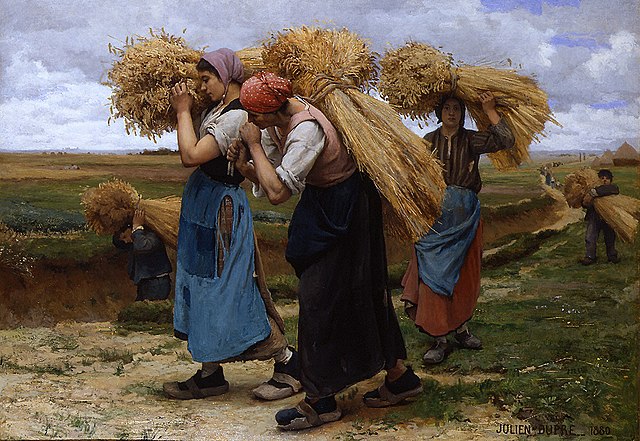Top Qs
Timeline
Chat
Perspective
Julien Dupré
French painter From Wikipedia, the free encyclopedia
Remove ads
Julien Dupré (French pronunciation: [ʒyljɛ̃ dypʁe], March 18, 1851 – April, 1910) was a French painter.[1][2]
Remove ads
Life and career
Summarize
Perspective

He was born in Paris on March 18, 1851 to Jean Dupré (a jeweler) and Pauline Bouillié.[1] It was expected that he enter the family business, and to that end Dupré began working in a shop that sold lace. However, his parents were forced to close their shop due to the war of 1870 and the siege of Paris. With time on his hands, Dupré began taking evening courses at the Ecole des Arts Décoratifs and it was through these classes that he gained admission to the École Nationale et Spéciale des Beaux-Arts.[3]
At l'Ecole he studied with Isidore Pils and Henri Lehmann. In the mid-1870s he traveled to Picardy and became a student of the rural genre painter Désiré François Laugée, whose daughter Marie Eléonore Françoise he married in 1876; the year he exhibited his first painting at the Paris Salon.[1]
Dupré received a gold medal at the Exposition Universelle of 1889 in Paris. In 1892, he was awarded the Legion of Honour.[1]
Dupré was teacher to Lucy Scarborough Conant.[4]
Throughout his career Dupré championed the life of the peasant and continued painting scenes in the areas of Normandy and Brittany.[citation needed] He exhibited regularly until his death in April, 1910.[1]
Remove ads
Works in public collections
Summarize
Perspective
Source:[2]
- The Hay Harvest (1881) - Chimei Museum, Tainan, Taiwan (R.O.C.)[5]
- Haying Scene (1884) - St. Louis Art Museum, St. Louis, Missouri
- The Haymakers (1886) - Worcester Art Museum, Worcester, Massachusetts
- Return From the Fields (n.d.) - Joslyn Art Museum, Omaha, Nebraska
- In Pasture (1882) - Washington University in St. Louis Art Gallery, St. Louis, Missouri
- Haying Scene (1882) - Washington University in St. Louis Art Gallery, St. Louis, Missouri
- Young Woman Watering Cattle - Museum of Fine Arts, Boston, Massachusetts
- Haymaking (1892) - Museum of Fine Arts, Boston, Massachusetts
- Children Feeding Geese (1881) - Museum of Fine Arts, Boston, Massachusetts
- Peasant Girl with Sheep (n.d.) - The Fine Arts Museums of San Francisco, California
- Milking Time (n.d.) - The Fine Arts Museums of San Francisco, California
- Women in the Fields (n.d.) - Bowdoin College Museum of Art, Brunswick, Maine
- The Young Shepherdess (n.d.) - San Diego Museum of Art, San Diego, California
- In the Pasture (1883) - University of Kentucky Art Museum, Lexington. Kentucky
- Le Ballon (1886) - Reading Public Museum and Art Gallery, Reading, Pennsylvania
- The Harvesters (1885) - The Appleton Museum of Art, Ocala, Florida
- The Harvester (c.1880/1) - Huntington Museum of Art, Huntington, West Virginia
- Home From the Pasture (n.d.) - Columbia Museum of Art, Columbia, South Carolina[citation needed]
- Woman Harvesting Hay (n.d.) - Museum of Fine Arts, Houston, Texas[6]
- The White Cow (La vache blanche) (ca. 1890) - Musée d'Orsay, Paris, France[7]
- Les faucheurs du luzerne (1880) - Musée d'Orsay, Paris, France[8]
Remove ads
Gallery
- Le repos dans les champs Rehs Galleries, Inc., New York City
- La bergère Rehs Galleries, Inc., New York City
- Femme avec des poules Rehs Galleries, Inc., New York City
- The Milkmaid Rehs Galleries, Inc., New York City
References
Bibliography
External links
Wikiwand - on
Seamless Wikipedia browsing. On steroids.
Remove ads





